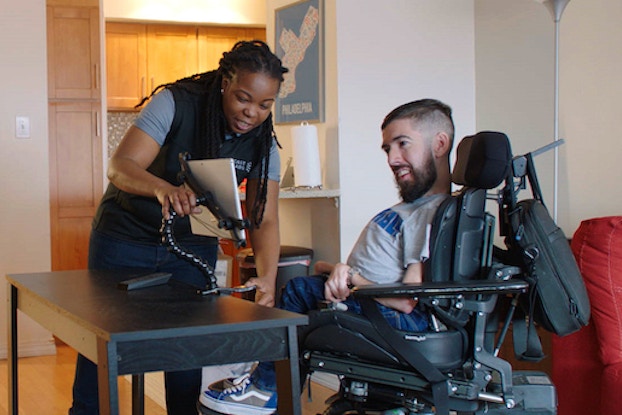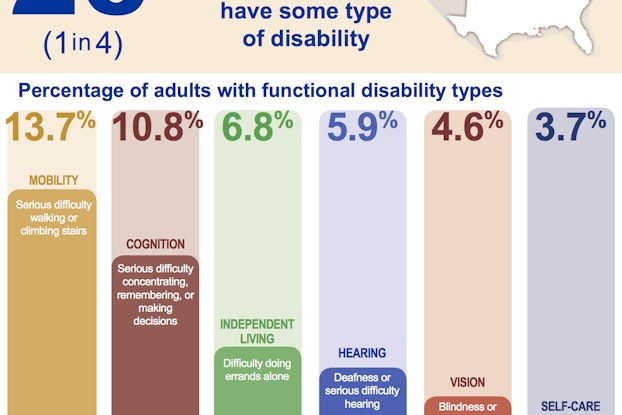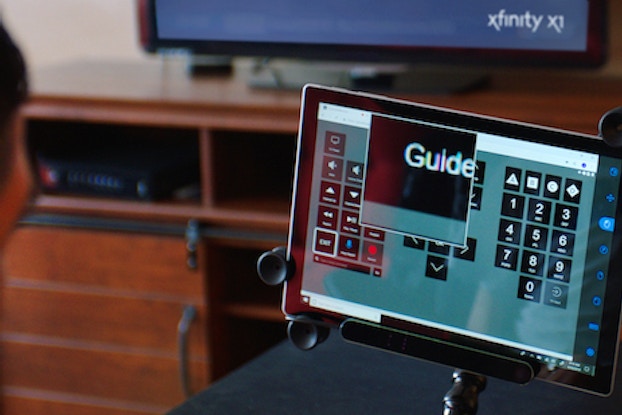
Comcast Corp. is introducing a new interface that promises to expand access to its services for people with certain disabilities, building upon a legacy of accessibility initiatives at the Philadelphia-based media conglomerate.
The parent company of Comcast Cable — which provides video, high-speed internet and phone services underthe Xfinity brand — has launched a feature that gives people with physical disabilities such as spinal cord injuries or amyotrophic lateral sclerosis (ALS) the ability to navigate their television using technology that tracks their eye movements.
“We’re taking our cloud-based, X1 operating system, and opening up the service to people with difficult disabilities,” Thomas Wlodowski, vice president of accessibility and multicultural for Comcast, told CO—. “We’re enabling a web remote control interface that allows someone who can't speak or hold a remote to independently change the channel, open up the program guide, select an on-demand movie to watch, schedule a DVR recording or bring up their home security cameras if they have Xnfinity Home as part of their package — all through their eye movements.”
The interface works using an eye tracking device such as the special camera system from technology provider Tobii Dynavox that projects tiny light beams onto a user’s eyes and studies the reflective pattern to determine where on the computer screen the user is focusing their gaze. Tobii developed the eye-tracking technology for use in gaming applications, and is now part of a small cadre of companies that are creating eye-tracking applications for people with neuromuscular impairments and other disabilities.

Businesses wake up to the needs of the disability community
Comcast is not alone in pursuing this market.
Across sectors from media to the retail, consumer goods and auto industries, businesses are waking up to the distinct needs of the disability community, in some cases tapping technology to make products and services more accessible and functional for the 26% of the adult U.S. population with a disability, according to the U.S. Census Bureau.
Under its ThisAbles project, IKEA offers items like a sofa designed with 3D-printed add-on legs that raise furniture to make it easier for those with mobility issues to get up and sit down.
Meanwhile, Rice Krispies Treats has offered braille stickers and recordable audio boxes for the vision-impaired, just as tech giants from Google to Apple have turned to artificial intelligence, computer vision and voice recognition technology to assist the disabled market with features such as FaceTime that enable communication for the deaf community via an iPhone, Mac or iPad.
We feel that this is just part of our commitment to building inclusive experiences for all customers.Thomas Wlodowski, vice president of accessibility for Comcast
It comes as businesses look to embed humanity into technology, as consumers increasingly expect just that, said Maxwell Luthy, director of trends and insights for TrendWatching, during the trend-forecasting firm’s seminar in New York City, attended by CO—.
Consumers are no longer going to be impressed by a brand that merely pays lip service to inclusivity via marketing, he said. “They’re more impressed [by companies that provide] practical solutions and products to serve consumers in tangible ways,” Luthy said, citing Marks & Spencer’s easy dressing line designed for children with a range of challenges, from feeding tubes to skin sensitivities, and an app from Chinese tech giant Huaweithat allows the visually impaired to "see" the emotion on the face of a person they’re talking to by translating it into sound.
Approximately 5,000 people in the U.S. are diagnosed with ALS each year, and it is estimated there are at least 16,000 Americans living with ALS at any given time, according to the ALS Association. Eye-tracking devices are also used by people with multiple sclerosis, stroke victims, quadriplegics or others with muscular diseases that inhibit their ability to use a physical remote or voice commands. More than 48 million people in the U.S. have some physical or mobility disabilities, according to the U.S. Census Bureau.
Many people with these disabilities already have eye-tracking devices for surfing the web or gaming. Anyone who can use the technology to navigate a web page can use it to control the Comcast interface, said Wlodowski.
“Essentially their eyes become the mouse pointer,” he said. “They maintain their gaze for a period of time over a specific link, button or control, then [the software interface] performs a mouse click on that button. It's basically a web version of what a hardware remote control device would look like.”

Alisa Brownlee, assistive technology specialist at the ALS Association, said eye-tracking technology has been an important tool for people living with advanced stages of ALS, when they become paralyzed and their eye muscles are often the only muscles they can control.
“Research has shown that when you are [in the advanced stages of ALS], 80% of people will need some kind of communication help,” she said, noting that ALS patients currently use eye-tracking technology for sending emails, making phone calls and sending texts, for example. “It’s their link to staying in touch with their family, their friends and their community.”
Although eye-tracking technology has evolved considerably, it can still pose some challenges for users, Brownlee said. It can be difficult for caregivers to calibrate accurately each day so that the system’s cameras are focused on the user’s eyes, for example, and it may need to be recalibrated if the user’s head slumps and their eyes fall out of range.
The technology has come down significantly in price since it was first launched, she said, and it is now often partially or even fully covered by health insurance.
The first ‘talking TV guide’ for the visually impaired
Wlodowski said Comcast’s cloud-based X1 infrastructure is facilitating the creation of technologies such as the eye-tracking interface, which can be downloaded onto a PC or tablet from the user’s home.
“That’s the beauty of X1,” he said. “It’s a cloud-based infrastructure that opens up opportunities like this.”

The eye-tracking technology represents just one aspect of an ongoing effort to enhance the user experience for Comcast customers with disabilities, said Wlodowski, who himself is blind.
Over the past few years, the company launched the industry’s first talking TV guide and introduced a voice remote control, for example, that leverages voice-control technology to allow visually impaired users to more easily navigate cable programming.
“They can hear the title of a movie, its rating, its Rotten Tomatoes rating — all the good information that they want,” Wlodowski said of the talking TV guide.
The voice-controlled remote allows users — blind or otherwise — to navigate programming using voice commands such as “Watch NBC” or even by speaking lines from a movie to call up that movie.
“That's a magical experience in a mainstream product, but it has real impact for some people with disabilities,” said Wlodowski.
For the 2016 Rio Olympics, NBC included a video description — in which narrators describe the action taking place on screen — with every primetime show throughout the Games, and then, for the first time ever, extended that feature to the 2018 PyeongChang Paralympics broadcasts on NBC and NBCSN.
Comcast also has a service center specifically dedicated to customers with disabilities where agents are specially trained in the company’s accessibility features and general support issues.
Wlodowski said the new eye-tracking feature fits within the company’s broader mission to expand accessibility for users of its products and services.
“We feel that this is just part of our commitment to building inclusive experiences for all customers,” he said.
-Barbara Thau contributed to this story.
CO— aims to bring you inspiration from leading respected experts. However, before making any business decision, you should consult a professional who can advise you based on your individual situation.
CO—is committed to helping you start, run and grow your small business. Learn more about the benefits of small business membership in the U.S. Chamber of Commerce, here.









